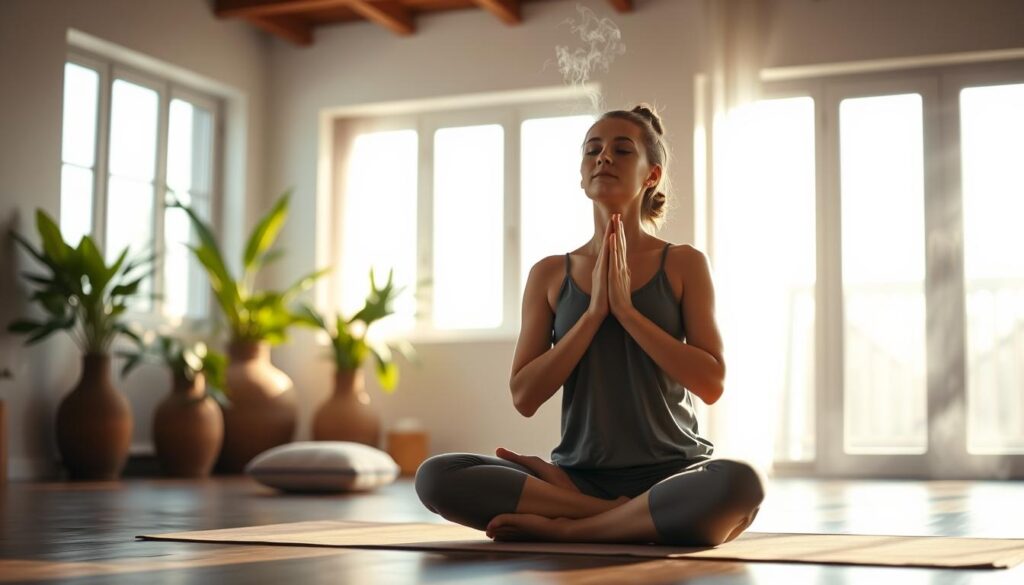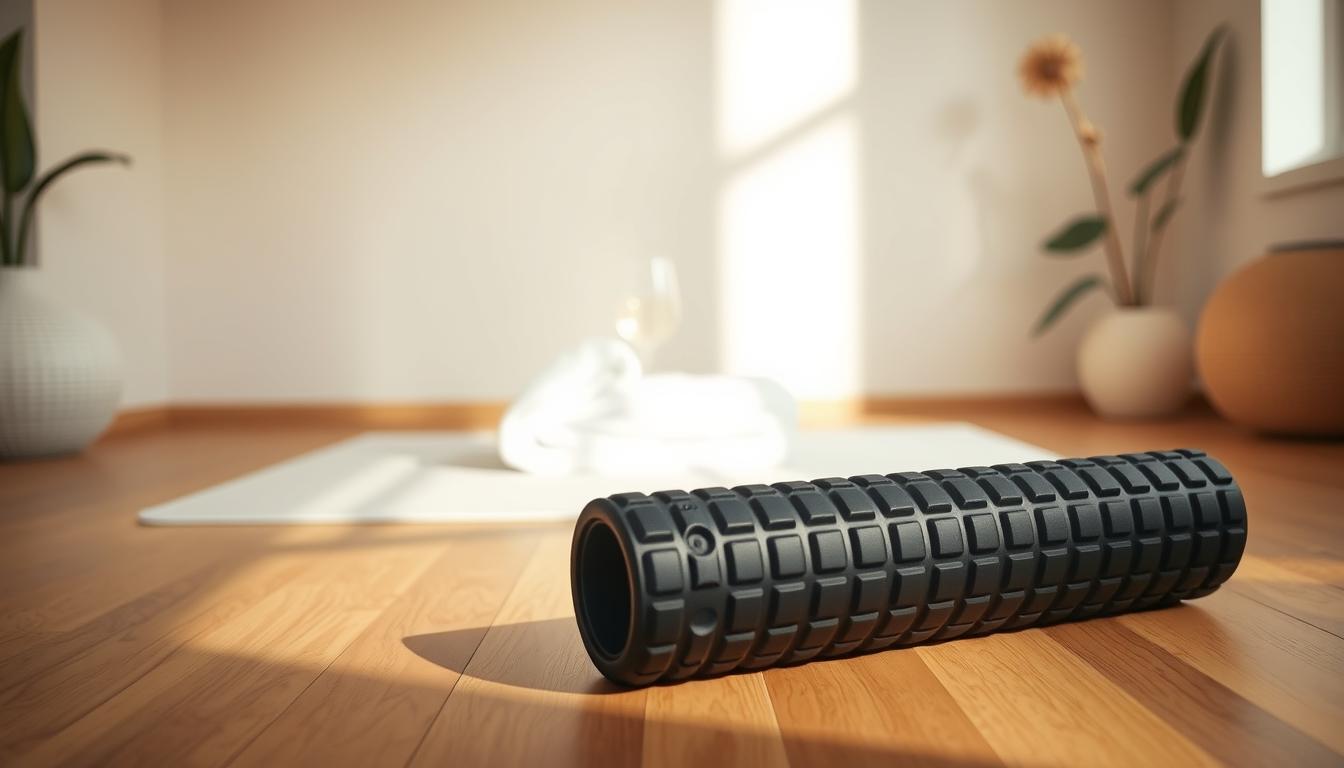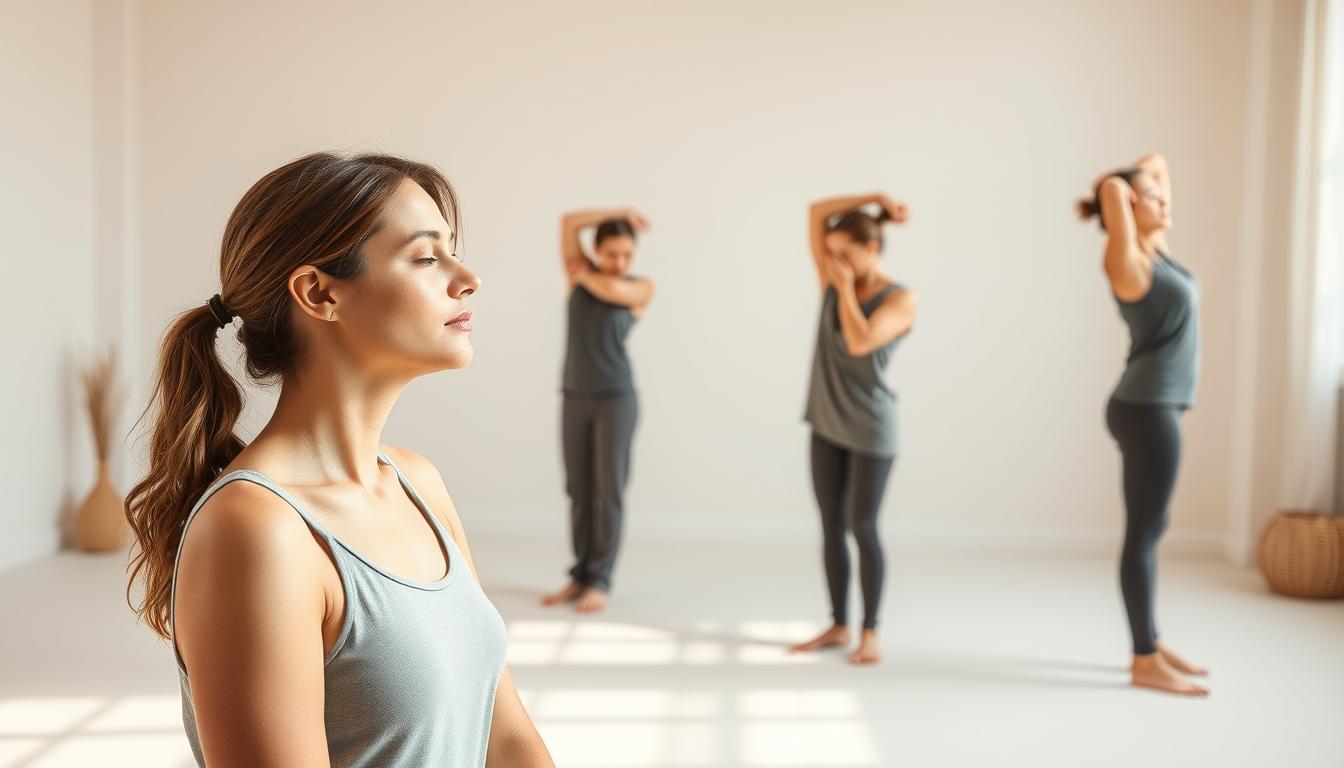Many people deal with chronic neck and shoulder pain every day. This can make it hard to do daily tasks and feel good. We’ll look at yoga poses that help with pain in the neck and shoulders.
Yoga is great for managing pain because it involves careful movement and stretching. It not only helps your body but also your mind. Doing specific yoga exercises can make your neck and shoulders more flexible and strong. It also helps you feel emotionally balanced.
Let’s dive into how yoga can offer relief and make you feel better. It’s easy to start and can really help improve your comfort.
Understanding Neck and Shoulder Pain
Neck and shoulder pain can come from different factors. Identifying the causes is key for effective relief. These conditions can significantly affect both your body and mind. Understanding the complexity of chronic neck pain is the first step towards dealing with it.
Common Causes of Neck and Shoulder Pain
Common causes of neck pain include:
- Poor posture during activities like computer work and cell phone use
- Arthritis or degenerative disc disease
- Repetitive strain from physical activities or manual labor
Causes of shoulder pain may involve:
- Injuries such as rotator cuff tears
- Inflammation from tendinitis or bursitis
- Stress-related muscle tension
Symptoms and Their Impact on Daily Life
It’s important to recognize neck pain symptoms for proper intervention. Symptoms can include:
- Tightness and tension in the neck
- Pain that spreads down to the shoulders and arms
- Headaches or migraines from neck strain
Chronic neck pain can interfere with daily life. It can make work, exercise, or rest difficult. Tackling these symptoms is crucial for better health and well-being.
The Benefits of Yoga for Neck and Shoulder Pain
Yoga helps a lot if you have neck and shoulder pain. It treats both your body and mind, making you feel better overall. By doing yoga regularly, your neck and shoulder condition can get much better.
Holistic Approach to Pain Management
Yoga treats pain in a full way, helping both your mind and body. The exercises make you more aware of how your body aligns. They also help you relax, which lowers tension. Doing yoga often can make painful episodes less frequent and less severe.
Improving Flexibility and Strength
Yoga is great for making your neck and shoulders more flexible and strong. You stretch and strengthen your muscles through different poses. This reduces current pain and helps avoid future pain too. Being more flexible also improves your muscles’ health overall.
Yoga Poses to Reduce Neck and Shoulder Pain
Yoga Poses for Pain Relief can greatly ease neck and shoulder pain. These moves help you relax muscles and recover better. They focus on where you usually feel the most tension. These are great for easing that tightness.
Top Effective Poses for Relief
- Warrior II Pose: This pose opens the chest and shoulders while building strength in the arms and legs.
- Extended Triangle Pose: Offers a deep stretch for the neck and shoulders, facilitating improved alignment.
- Child’s Pose: A resting position that calms the mind and stretches the back, providing gentle relief to the upper body.
How Poses Help in Recovery
These poses help not just now but also in the long run. They make muscles stronger and more flexible and improve how you stand. With more flexibility and strength, your muscles won’t be as tight. This helps you manage tension effectively.
Preparation Before Practicing Yoga
Before starting a yoga session for neck and shoulder relief, getting ready is key to success. It’s crucial to follow safety steps and talk to a health expert. This ensures your yoga plan fits your specific health needs and pain levels.
Consulting a Healthcare Professional
Talking to a healthcare expert is crucial if you have severe or sudden neck pain. This advice helps you understand what’s safe for you and any special steps to take. A pro can tailor a yoga routine that’s safe and right for your health.
Setting Up Your Space for Yoga Practice
To get ready for yoga, set up a welcoming space. A perfect spot is quiet, without distractions, aiding in focus and calm. Here’s what to include:
- Remove clutter for an open feel.
- Use mats for comfort in poses.
- Soft lighting adds a soothing vibe.
- Props like blocks or straps give extra support.
Taking time to prepare for yoga boosts the experience. It helps you concentrate on your goals and get the most from each pose.
Essential Yoga Poses for Neck and Shoulder Discomfort
Some yoga poses can really help if you have neck and shoulder pain. Each one has special benefits to ease tension and make you feel better. Here are some top poses to try.
Standing Forward Bend Pose
The Standing Forward Bend Pose is great for your upper body. It lets you stretch in a way that feels healing and calming. When you bend forward, your neck and shoulders get to relax, helping with any discomfort.
Warrior II Pose
Warrior II strengthens your shoulders and helps open your chest. This makes your neck align better and improves your posture. Doing this pose often can really help strengthen and stabilize your shoulders.
Extended Triangle Pose
The Extended Triangle Pose stretches the sides of your body. It really helps release pain in your neck and shoulders. Adding this pose to your yoga can help you feel better for a long time.
Incorporating Breathwork and Mindfulness
Adding Yoga Breathwork to your routine makes it much more effective. Paying attention to your breath helps you relax and move more smoothly between poses. Realizing how vital breathing is in yoga helps you connect more with your body. This is especially true for tense areas like the neck and shoulders.
The Importance of Breath in Yoga
Breathing right is key to good yoga. Focusing on breathing in and out sets a pace that keeps you in the moment. This attention reduces physical pain and clears your mind. Both new and experienced yogis find Breathwork helps focus and energize them during yoga.
Mindfulness Techniques to Enhance Practice
Mindfulness turns our busy lives into a place of peace during yoga. Using body scans and focusing on how things feel intensifies this effect. Mindfulness lets you let go of stress and welcome calmness. Pairing this with Yoga Breathwork improves how we handle our emotions and our overall health.

General Tips for Practicing Yoga Safely
Being mindful when you do yoga, especially if your neck and shoulders hurt, is key. It’s important to adjust yoga to fit how comfortable you feel. Knowing your body well can make yoga more rewarding and effective each time.
Adapting Poses for Your Comfort Level
Changing poses helps everyone feel at ease and sure of themselves when doing yoga. Here are some tips:
- Start with gentle modifications to strong poses
- Utilize props such as blocks, straps, or cushions
- Experiment with variations to find what feels best
These changes can make yoga more enjoyable and keep you from hurting more.
Listening to Your Body for Effective Practice
Awareness of your body is crucial in yoga. Notice if you feel discomfort, and change how you’re posing if needed. Watch out for these signs:
- Muscle tightness or tension
- Sharp or pinching sensations
- Fatigue or strain in specific areas
By really listening to your body, you can better understand it during yoga. This helps you be more comfortable and safe in your practice.
Real-Life Experiences and Testimonials
Many people have shared how yoga helped with their neck and shoulder pain. These stories show yoga’s power to not only ease pain but also boost well-being. Users noticed better flexibility, more energy, and improved emotional health.
User Stories on Relief from Neck and Shoulder Pain
Yoga testimonials often talk about significant pain relief. People found that gentle yoga moves and relaxing postures made a big difference. Those facing long-term pain found hope and support in these stories, feeling encouraged that yoga could help them, too.
How Yoga Changed Their Quality of Life
Those practicing yoga have seen big improvements in their lives. Regular yoga practice helped them move past the limits pain set, bringing more happiness and positivity. Besides physical benefits, they also gained mental clarity and emotional strength. Many are thankful for the joy yoga brought back into their lives.
Conclusion
Yoga is a great help for those with neck and shoulder pain. It offers not just physical relief but boosts mental and emotional health, too. By combining breath control and mindfulness, yoga gives a full-circle approach to wellness.
Becoming better requires practicing yoga consistently. Adding yoga to your daily life can really help manage neck and shoulder issues. It’s not only about easing pain but also about building a healthier, stronger you for the future.
Yoga can truly change how you feel, offering a way to better handle neck and shoulder pain. It’s more than just exercises; it’s about healing and connecting with your body. By welcoming yoga into your life, you open the door to long-lasting well-being.



